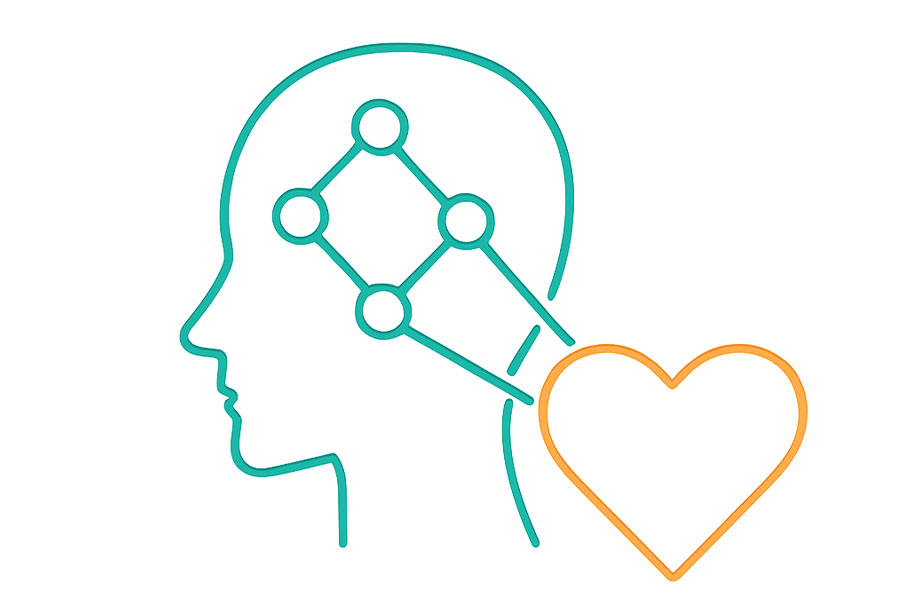Article Overview:
Introduction
Have you ever experienced neural empathy, that magical phenomenon that deeply stirs your emotions when watching an ad or a film, moving you to laughter, tears, or even grief? Imagine you're watching a movie and suddenly realize your eartbeat is synchronized with the main character's. Have you ever had such a profound experience of identification? This is the magic of neural empathy – a phenomenon where our brains send the same neural signals as if we were experiencing the situation ourselves. Neural empathy has extensive applications not only in everyday life but also in the world of digital marketing.
Emotional storytelling has long been one of the most powerful tools for conveying human emotions and experiences. From the mythological tales told on long nights to classic novels that have touched hearts for centuries, this form of communication has always played a significant role in shaping human understanding and emotions. But what makes a story so impactful? The answer lies in the connection between emotional storytelling and neural empathy: when a narrative can deeply engage the audience's emotions, its impact transcends a temporary moment and becomes memorable.
In the world of digital marketing, this characteristic of the human mind creates a unique opportunity for brands to deliver impactful and emotional stories. When a brand uses emotional storytelling along with an understanding of neural empathy, it can craft a message that not only conveys information but also directly affects the emotions and experiences of the audience – an approach that leads to the creation of deep and lasting engagements with the audience.
This article delves into the phenomenon of neural empathy and its role in emotional storytelling, demonstrating how the intelligent use of this combination gives brands an amazing ability to establish a deep and meaningful connection with their audience. Through concrete examples from films, series, and stories of famous brands, the concept of neural empathy is clarified, and the key elements of emotional storytelling are discussed. In the end, practical solutions are presented for implementing these strategies in digital marketing campaigns.
If you want to know how this magical combination can guarantee your brand's success and build a lasting connection with your audience, don't miss the rest of this article!
When Their Feelings Become Your Own!
Neural empathy is a state where our brains, upon witnessing or hearing about an experience, fire the same neural signals as if we were living it ourselves. This phenomenon is linked to the activity of mirror neurons in the brain, which our brains use to feel the experiences of others as if they were our own. These neurons enable us to understand the emotions of others and, in a way, empathize with them. Various parts of the human brain, such as the prefrontal cortex, amygdala, and limbic system, play a role in processing emotions and neural empathy.
The concept of neural empathy was first discovered in the 1990s by Giacomo Rizzolatti and his colleagues at the University of Parma, Italy. They observed that in macaque monkeys, specific neurons in the premotor cortex were activated both when performing an action and when observing that same action being performed by others.
Neural Empathy in Action
To better grasp this concept, imagine encountering a character in a movie who's facing a difficult situation. You might put yourself in their shoes and feel as though you're experiencing the same emotions. This is neural empathy being activated subconsciously. Well-known examples of films and TV series that leverage neural empathy:
Why Does Emotional Storytelling Capture Hearts?
Emotional storytelling is both an art and a science, connecting with the mind and heart of the audience by stimulating their emotions. By engaging the emotional parts of the brain and activating neural empathy, it creates a deep and lasting connection. Stories can awaken emotions such as joy, sorrow, excitement, hope, or even fear in the audience. The art of this type of narrative lies in targeting emotions rather than relying on logic, establishing a deeper and more human connection with the audience, because neural empathy allows us to experience stories not only auditorily but also as a real emotional experience. Factors That Make Emotional Storytelling Effective:
Direct Connection to the Primal Brain
Emotional stories connect directly with the primitive and emotional parts of the brain (the primal brain). This part is responsible for rapid decision-making and emotional reactions; therefore, narrative messages, along with the activation of neural empathy, have a greater impact than purely logical messages.
Greater Retention in the Mind
Emotional narratives create greater retention in the mind of the audience due to the simultaneous stimulation of emotions and memory. This stability, through the consolidation of neural empathy, ensures that the audience remembers the brand and returns to it in the future.
How Does Emotional Storytelling Work?
This process emotionally engages the brain while influencing the memory and decision-making of the audience. Here are the stages of how emotional storytelling functions:
Stimulating Emotions
By using narrative and emotional elements (such as joy, sorrow, or excitement), the limbic system of the audience's brain is activated, and they become naturally involved in the emotional storytelling. At the same time, the brain, by activating the limbic system and utilizing mirror neurons, generates similar emotional reactions, which enhances the impact of neural empathy in the storytelling experience.

Creating Identification
The brain, with the help of mirror neurons, mimics the emotions of the story's characters, so that the audience deeply connects with the message and the depth of the story and, based on neural empathy, considers themselves a participant in the story. This helps to create a deep identification with the narrative
Type of Emotional Storytelling
When Empathy and Emotion Transform Digital Marketing
Emotional storytelling in digital marketing means using narrative techniques to stimulate emotions and create an emotional connection, conveyed to the audience through digital tools such as websites, social networks, emails, and digital advertising. The connection to neural empathy plays a vital role in this space, enabling brands to establish deeper connections with their audiences. Here's how this process works specifically in the digital space:
Using Digital Content to Create Shared Emotions:
Content in digital marketing (such as social media posts, YouTube videos, blogs, podcasts, and personalized emails) specifically responds to the audience's emotions. This content reflects the audience's common challenges, victories, or needs and strengthens the sense of empathy and emotional engagement through emotional narratives
Using Advertising and Interactive Content:
Digital advertising and interactive content (such as high-quality videos and Instagram stories) are effective tools for creating empathy. When a brand tells its emotional stories in these formats, the audience feels directly involved in the decision-making process or experience; this type of interaction creates a deep and lasting connection with the brand.
Personalizing Stories:
Adapting stories and messages to the specific needs and emotions of each audience member, i.e., personalizing digital content, can create a deeper emotional connection. Brands use personalized emails and targeted advertising to tailor their content based on the audience's purchase history and interests; this makes the audience feel that the brand is designed specifically for them.
Creating a Sense of Belonging Through Continuous Storytelling:
Emotional storytelling in the digital space must be done continuously and through multiple communication channels to strengthen the emotional connection with the audience. Continuous use of email marketing, social networks, and websites to deliver engaging stories creates trust and increases the audience's emotional engagement with the brand.
Creating Meaningful and Impactful Endings:
The endings of stories in digital marketing should be designed with a specific and impactful purpose. Each ending can create a particular feeling in the audience and influence their decision-making, leaving a lasting memory and a deep connection with the brand.
Here are a few types of ending that are effective in this text:
- Happy and Pleasant Ending: Create a sense of satisfaction and emotional connection, strengthening the bond.
- Inspirational Ending: Motivate and remind individuals of their ability to make positive changes.
- Informative Endings: Provide educational messages and encourage further thinking for informed decisions.
- Challenging Endings: Stimulate thought and change the audience's behavior.
- Surprising Endings: Shift the audience's perception and draw attention to new features of the brand.
- Nostalgic Endings: Awaken old emotions and create a deep emotional connection.
The Power of Storytelling for Successful Brands in the Digital World
Nike and the "Just Do It" Campaign
Dove and the "Real Beauty" Campaign
Apple and Launch Events

Patagonia and Environmental Protection Campaigns

Common elements in these brands' digital marketing include storytelling based on values for a deep connection with the audience, the use of social networks for interaction and creation of online communities, encouragement of user-generated content to be present in their daily lives, and the provision of a personalized user experience to increase customer loyalty and satisfaction.
How does bazarento multiply engagement through the art of storytelling in digital marketing?
Understanding the Audience: The First Step in Every Campaign
At bazarento, every story begins with a thorough analysis of the audience to ensure that the brand's message aligns with their concerns and goals. This deep understanding of the audience lays the groundwork for selecting the appropriate content and approach in storytelling.

Creating Strong and Emotional Stories for Brands Based on Neural Empathy
We design stories that align with the brand's identity and emotionally engage the audience. These emotional narratives create a deep bond between the brand and the audience.

Choosing the Best Channel for Telling Stories
By analyzing the characteristics of the audience, we use effective platforms such as Instagram, YouTube, and podcasts to convey the brand's story. This channel selection delivers the brand's message to the audience effectively and purposefully.

Personalizing Content for Each Audience Member
By leveraging precise data, we tailor stories to the specific needs and interests of each group of audience members. This personalization creates a deeper connection between the brand and the audience.

Measuring Results to Improve Campaigns
bazarento can accurately assess the impact of stories using innovative technologies (such as artificial intelligence and psychological data analysis) and present the results in understandable reports.

Conclusion
Capturing Hearts in Digital Marketing with Empathy and Storytelling (What We Learned)!
Understanding the neuroscience of emotional storytelling provides valuable insights for marketers to design their digital marketing campaigns in an engaging and impactful way. By harnessing the power of emotional storytelling and activating neural empathy, brands can establish a deep and emotional connection with their audience; this not only helps increase brand recall and customer loyalty but also gives them a significant advantage in the competitive digital marketing landscape.
Building compelling narratives involves several key elements: first, creating relatable characters and situations that the audience can see themselves in; second, using sensory details and vivid descriptions that allow the audience to have a deep experience of the story; and third, having a coherent structure with a clear narrative arc that creates tension and resolves the story's conflicts. These factors help neural empathy to embed the story's message deeply in the audience's mind.
By precisely understanding brain responses to emotional stories, marketers can improve their digital campaigns and establish a dynamic and lasting connection with customers. Investing in this approach, by combining neural principles and emotional storytelling, differentiates brands in the digital marketing space and increases conversion rates and customer loyalty.
Article writer

Mehrnoosh Choobandian
Director of Bazarento
Ph.D. in Marketing
Marketing & Branding Strategist
Take Your Storytelling to the Next Level
Ready to harness the power of neural empathy in your brand's storytelling? Explore our services to elevate your emotional connection with your audience



“This gave me chills. Now I know why some stories hit me so hard.”
Thank you for your time. We are glad this article informed you.
thank you
“I’ve always felt more connected to brands that share real, imperfect stories — like someone talking directly to me. This article helped me understand that there’s a neurological reason why that type of content builds trust. Really insightful.”
We are glad that this article was enlightening for you